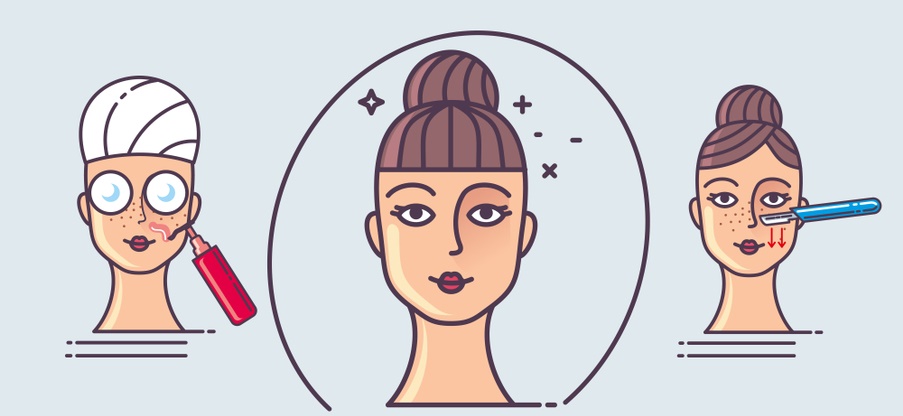Dermaplaning, the removal of hair from the face, is considered a guarantee treatment for a radiant complexion and youthful appearance. What’s the truth behind this trend? We get to the bottom of the advantages and disadvantages of the treatment and explain how it is done properly.
Shaving the face is no longer just a man’s job: in Asia and Hollywood, dermaplaning has long been a big issue. Here, women also regularly have their facial hair removed to give their skin a special glow. In this country, more and more female beauty fans are also turning to the razor to remove hair on the upper lip. to get to grips with hair on the upper lip, cheeks, chin, forehead and nose. Cosmetic studios offer special dermaplaning treatments and there are now some special hair removal tools for use at home.
The benefits of dermaplaning
Dermaplaning isn’t just about removing noticeable facial hair. Especially the little baby hair or the fuzz that likes to be on the cheeks or above the upper lip is removed with the technique. This alone makes the complexion look fresher and more radiant. Because: If you look closely in the mirror, you can see that it is precisely these thin, barely noticeable hairs that cover the skin in areas. In addition, powder and make-up get stuck in it when applying make-up – the complexion looks more uneven and not really smooth. The skin only maintains glow if it can fully reflect the incident light. This doesn’t work properly with powdered hair on your face.
But dermaplaning also has another effect. The razor also removes dead skin, similar to a peeling. This also makes the facial skin look rosier, because under the scales there are new, young skin cells that now receive more oxygen and can work more actively. In addition, the skin absorbs nutrients from skin care products better after a dermaplaning treatment – serums, masks and creams have an even more intense effect.
Advantages of dermaplaning at a glance:
- The hairs on the face disappear
- dead skin cells are removed
- The complexion appears more even and radiant
- the complexion appears rejuvenated
- Make-up can be applied more evenly
- neat appearance
- Facial care is better absorbed by the skin
- can counteract skin impurities
Does dermaplaning also have disadvantages?
Since dermaplaning is done with a sharp blade, consider leaving the treatment in the hands of a knowledgeable person. As with shaving, this type of hair removal can lead to slight cuts and scratches. Who wants to have that in their face? However, there are now special dermaplaning blades that make handling at home very easy and uncomplicated.
With very sensitive skin, redness and irritated skin can occur after dermaplaning. However, these disappear again after a short time. Dry skin can become tight after the treatment, which can be regained with a moisturizer.
For whom is dermaplaning not suitable?
Anyone who suffers from extremely sensitive skin, acne, rosacea, psoriasis, neurodermatitis or eczema on the face should rather avoid dermaplaning. Symptoms may intensify here. In addition, the risk of injury is slightly increased with uneven skin.
Women who have a lot of facial hair with darker and thicker hairs should also stay away from dermaplaning. Here it can happen that hair grows in and pimples form. Instead, in this case you should resort to another type of facial hair removal such as waxing, epilation or the thread method.
Possible disadvantages of dermaplaning at a glance:
- very sensitive skin can become irritated
- redness and itching may occur
- dry skin can be tight
- slight risk of injury (mainly with bad tools and too fast, careless handling)
- not recommended for acne, neurodermatitis, psoriasis, rosacea and eczema
- not recommended for very heavy hair growth on the face
Dermaplaning at home: Explained step by step
For dermaplaning you will need: an eyebrow razor or facial razor for women (these are better than traditional body razors or razors for men). Special dermaplaning blades are now also available in stores.
- Take your time. You should have a steady hand to avoid scratching the skin.
- Cleanse your face with a washing lotion or cleansing cream. You can also apply a facial toner. A water with ingredients that soothe the skin is particularly recommended here. The work then continues on dry skin. Dermaplaning is carried out without shaving foam or the like.
- Now shave the face with short and quick strokes from top to bottom. A magnifying mirror helps ensure that no areas are left out. It is better to avoid pigment spots and pimples (risk of injury)
- Then apply a mild moisturizer
- In the days immediately after dermaplaning, it is important to protect the skin from solar radiation, as the skin is more sensitive to the sun than it was before the treatment. There is a risk of pigment spots and sunburn. So be sure to use sunscreen with a high sun protection factor!
Tip: Perform the treatment in the evening before going to bed. Then clean your face anyway and your skin can recover overnight.
If you like the result, you can repeat the treatment – depending on hair growth – every two/three weeks.

